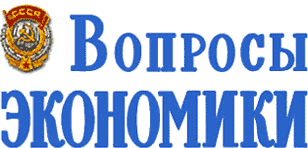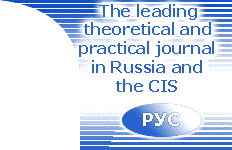|
MACROECONOMICS
|
|
|
__________________
|
LABOR MARKET
|
|
FROM THE HISTORY OF RUSSIAN
SOCIAL THOUGHT
|
|
|
IN AID TO THE LECTURER
|
|
NOTES AND LETTERS
|
- V. Zhilina, M. Starovoitov - Housing Policy in Volgograd Oblast'
Abstracts
|
|
E. Yasin. Burden of the State and Economic Policy (The Liberal Alternative)
|
|
The article focuses on the analysis of the state burden in the Russian economy. The author investigates the dependence of economic processes in the Russian economy on the level and structure of the government expenditures, activities of various spheres of the public sector and some other factors of the state participation. It is shown that for maintenance of steady economic growth in the long-term period it is necessary to decrease the state burden in the Russian economy. The directions of possible reduction of government expenditures and spheres of state influence are described.

|
|
V. Kuleshov, V. Marshak. Financial Aspects of Economic Growth Fore casting
|
|
The results of the analysis of the economic role of the government based on the system of monetary circulation models are described in the article. Two approaches are investigated. According to the first, which is taking place today, the government does not perform the role of the proprietor only forming the rules of the game (the monetarist variant). In the framework of the second approach the government participates in the investment process playing according to the rules common for all market agents (the Keynesian variant). The principle description of the model and the results of modeling are given.

|
| font size="2" face="Verdana" color="#ffffff">
G. Rakitskaya. Relations between Workers and Employers in Contemporary Russia (1987-2001)
|
|
In the present transitional period in Russia one can discern three different periods in the ideological and practical struggle dealing with the transformation of relations between workers and employers: the pre-revolutionary and revolutionary situations (1987-1991); the "globalizational" shock reforms and consolidation of their results (1992-1999); the post-Eltsin "state modernization" (from 2000). The article presents general characteristics of each period and their comparative analysis relative to the state of social consciousness and real tendencies in the transformation of social-production relations. The ideology of "partnership" and the perspectives of its realization in contemporary Russia are subjected to critical analysis.

|
|
T. Chetvernina. Russian Unemployment Security System in the Context of the International Experience
|
|
The article examines general tendencies in the development of the unemployment security system during XX century and main types of existing models. Basing on the international experience, the author analyses the factors that have led to the crisis of the labour market policy in Russia and put obstacles in the way of creation of the effective unemployment security system. The article describes advantages and disadvantages of the direct implementation of the European highly protected model in the Russian reality. The author investigates main directions of reforming the existing system in Russia.

|
|
Dynamics and Factors of the Effectiveness of Professional Training of the Unemployed
|
|
Various aspects of the effectiveness of professional training of the unemployed are considered in the article. The analysis is based on statistical information and results of the survey of employment agencies in 5 regions of RF. The authors conclude that improvement of professional training of the unemployed can be achieved by modernization of employment agencies technologies and by strengthening the connections of main social partners acting on the labor market.

|
|
V. Gimpelson. The Number and Composition of the Russian Bureaucracy
|
|
The paper examines social and demographic composition of civil servants in federal ministries, regional and municipal administrations in Russia in the second half of the 1990-s. Basing on statistical data, the author estimates the size of the Russian bureaucracy and its main social and demographic characteristics. In the 1990-s, the number of civil servants grew in regions while at the federal level it declined. The composition of the civil service was characterized by strong gender and age asymmetry. Intensive turnover at the bottom of bureaucratic hierarchy contrasts strongly with stability of the upper middle and upper levels officials. As a result, junior employees have strong disincentives for the civil service carrier. This leaves senior officials without any competition pressure from below and from the outside and contributes to the malfunctioning of the Russian bureaucracy.

|
|
I. Tsapenko. "Renaissance" of Economic Migration in the West
|
|
The article deals with historical forms and recent trends in economic migration in western countries. It is demonstrated that the use of foreign labor force has multidimensional consequences for the receiving societies. Modern approaches of western states to economic migration that are aimed at attracting foreign workers in demand, entrepreneurs and investors are analysed.

|
|
L. Abalkin. N.Ya. Danilevsky about Russia, Europe and Slavic Unity
|
|
Basic issues of the book by N. Danilevsky "Russia and Europe. The View on Cultural and Political Relations of the Slavic World with the German-Roman" are considered in the article. For the first time in the world science historical types of civilizations had been investigated in the book. It is possible to assert that N. Danilevsky was the founder of the civilizational approach.

|
|
R. Nureev. Public Choice Theory. A Textbook. Chapter 4. Public Choice under Direct Democracy: Unanimity Rule and Majority Rule
|
|
The specifics of public choice under direct democracy are considered in the fourth chapter of the textbook. The focus is made on basic democratic mechanisms of decision-making such as unanimity rule and majority rule. The last one is considered in positive and normative sense. The optimal majority is defined and the medium voter theorem is analysed (one-dimensional and multi-dimensional cases). The chapter also includes further readings, control tests and questions.

|



